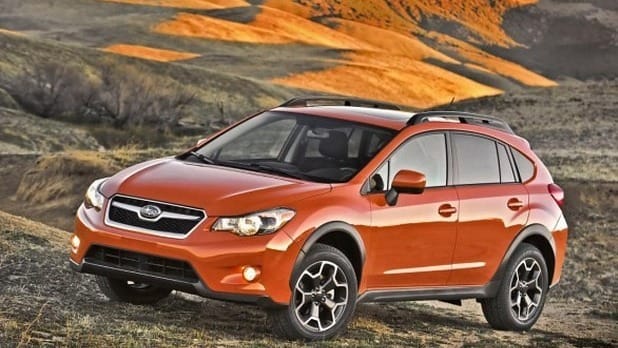VW ID.4 or Audi Q4 e-tron

Since SUVs are the most well-liked cars in Switzerland currently, it is not surprising that the electric market is full of EV-SUVs. Two of the biggest contenders in Switzerland are the Volkswagen ID.4 and the Audi Q4 e-tron. These two vehicles share the same basic platform, meaning they have a lot in common under the skin, but they appeal to very different types of people.
The ID.4 is aimed at those looking for affordability, practicality, and efficiency, while the Q4 e-tron offers a more premium experience with a refined interior and better driving dynamics. But which one should you choose? Gowago gives you an overview of both cars so that you can make the right decision for yourself when the moment comes.
- VW ID.4 or Audi Q4 e-tron: The Main Differences
- Practicality
- Equipment
- Interior
- Performance and Driving Experience
- Costs of the VW ID.4 and Audi Q4 e-tron
- Conclusion
| VW ID.4 | Audi Q4 e-tron | Gowago Leasing New | from CHF 525 / month | from CHF 700 / month |
|---|---|---|
| Gowago Leasing Used | from CHF 370 / month | from CHF 400 / month |
| General | - Focuses on affordability, efficiency, and practicality. - Built on Volkswagen’s MEB platform, sharing parts with Skoda Enyaq. - Simpler design with user-friendly features. |
- Offers a premium driving experience with better refinement. - Built on the same MEB platform but with higher-end materials. - More sophisticated infotainment and interior feel. |
| Practicality | - Spacious cabin with 543L boot capacity, slightly larger than the Q4 e-tron. - Flat floor improves comfort for middle-seat passengers. - Lacks a frunk, but has generous interior storage. |
- More rear legroom with slightly more comfortable rear seating. - 520L boot capacity, but offers underfloor storage for charging cables. - No frunk either, but better interior layout and ergonomics. |
Equipment | - 12.9-inch touchscreen with Apple CarPlay & Android Auto. - Basic regen braking modes (D & B) for energy recovery. - Frustrating touch-sensitive controls, which are less intuitive. |
- 11.6-inch touchscreen with better responsiveness & Amazon Alexa. - Paddle-controlled regen braking offers adjustable energy recovery. - More physical buttons, making everyday use easier. |
Interior | - Uses more hard plastics, giving a utilitarian feel. - Seats are comfortable but firmer, less suitable for long trips. - Infotainment is laggy and touchscreen-reliant, making it less user-friendly. |
- Premium materials, including soft-touch plastics and brushed aluminum. - Superior seat comfort with better lumbar support and quieter cabin. - Intuitive infotainment system with physical climate control buttons. |
Driving Experience | - Smooth and easy to drive, but lacks sporty feedback. - Slightly firm suspension, especially with larger wheels. - ID.4 GTX (335hp) does 0-100 km/h in 5.4s, offering a sportier feel. |
- More refined and quieter ride with improved steering feedback. - Better chassis refinement, leading to a more premium driving experience. - Q4 55 e-tron (340hp) achieves 0-100 km/h in 5.4s, with AWD for added stability. |
Fuel Consumption | VW ID.4: up to 540km | Audi Q4 e-tron: up to 520km |
VW ID.4 or Audi Q4 e-tron: The Main Differences
What makes the Audi Q4 e-tron and VW ID.4 different?
If you’re looking for a practical, family-friendly electric SUV, chances are you’ve come across both the Volkswagen ID.4 and the Audi Q4 e-tron. They are two of the most popular in Switzerland after all. These two vehicles share a lot beneath the surface—they’re both built on the same platform by the Volkswagen Group, have similar battery options, and target buyers transitioning to electric mobility. But that’s just about where the similarities end.
The Volkswagen ID.4 is all about value for money, prioritizing space, efficiency, and ease of use. It’s an electric crossover that delivers on range, affordability, and practicality - and it does its job well, but without massive excitement.
The Audi Q4 e-tron, on the other hand, takes the same fundamental package and adds a layer of premium refinement. It has a higher-quality interior, better driving dynamics, and a more sophisticated infotainment system—but this obviously comes at a price.
Discover VW ID.4 Leasing Options with Gowago
Another key difference? Technology. The ID.4's infotainment system is frustrating, with touch-sensitive controls that lack physical feedback. While being futuristic and state-of-the-art, this can be distracting while on the road. Audi, while still fully embracing touchscreens, has managed to retain more physical buttons, making everyday operation much more intuitive.
On the road, the Q4 e-tron is more refined, with a smoother ride and better sound insulation, whereas the ID.4 can feel a bit firm at low speeds. If you're after a budget-conscious EV with lots of space, the ID.4 is your pick. If you want a more premium experience without jumping to a even higher class, the Q4 e-tron is worth the extra cost.
Find your new Audi Q4 e-tron Leasing!
Practicality
How practical are the VW ID.4 and Audi Q4 e-tron?
Both the Volkswagen ID.4 and the Audi Q4 e-tron are designed to be everyday electric SUVs. But which one is better suited for family life?
Seating and Cabin Space
Both SUVs offer five seats, but the Audi Q4 e-tron has slightly better rear passenger legroom. Thanks to its flat floor, the ID.4 makes good use of space, especially for middle-seat passengers, which don’t feel too squeezed in.
Boot Space
When it comes to cargo capacity, the Volkswagen ID.4 edges ahead. It offers 543 liters of boot space, compared to the Audi Q4 e-tron's 520 liters. Neither car offers a frunk (front trunk), meaning storage space is limited to the rear boot and cabin compartments - it’s traditional, but don’t fix what isn’t broken. However, the Q4 e-tron does have underfloor storage for charging cables, which is a plus.
Storage Solutions
Inside the cabin, the ID.4 has larger storage compartments, but the Q4 e-tron is better laid out. The ID.4’s centre console has large bins, while the Audi’s is smaller but more ergonomically designed compartments. Overall, if boot space matters more, the ID.4 wins. If passenger comfort and interior layout are your priorities, go for the Q4 e-tron.
Equipment
What is the equipment of the Volkswagen ID.4 and the Audi Q4 e-tron like?
Safety Features
Both cars come with a strong suite of safety features, including:
- Adaptive cruise control
- Lane-keeping assist
- Autonomous emergency braking
- Rear parking sensors
However, the Audi Q4 e-tron has more premium safety tech available as options, such as Matrix LED headlights and lane-changing assistance.
Technology
The ID.4 gets a 12.9-inch touchscreen, but its software can be glitchy and frustrating to use. It does have ChatGPT integration though, so in case you suddenly have questions about the complexity of the fall of the Roman empire while you are on the road, the ID.4’s center console will gladly help you with that.
The Audi Q4 e-tron features an 11.6-inch screen that is more intuitive, with better responsiveness and Amazon Alexa integration. Both cars come with Apple CarPlay and Android Auto as standard, but the ID.4’s system is more prone to lag.
Another key difference is regenerative braking. The ID.4 has just two modes (D & B), while the Q4 e-tron offers paddles behind the steering wheel for adjustable regenerative braking.
Interior
What is the interior of the Volkswagen ID.4 and the Audi Q4 e-tron like?
If you’re after luxury, the Audi Q4 e-tron is the clear winner. Its cabin feels distinctly premium, with high-quality materials, a sleek design, and a more refined finish compared to the Volkswagen ID.4.
The Q4 e-tron features soft-touch surfaces, brushed aluminum accents, and plush upholstery, with the option for leather-wrapped seats that add an extra level of sophistication. Meanwhile, the ID.4 takes a more functional approach, utilizing hard plastics and a minimalist design that, while practical, lacks the upscale feel of the Audi.
Discover VW ID.4 Leasing Options with Gowago
Comfort-wise, the Q4 e-tron excels with its well-cushioned seats that provide superior lumbar support, especially on long journeys. The ID.4's seats are comfortable but firmer, which may not be as accommodating for extended trips. Additionally, the Q4 e-tron’s cabin is quieter, with better insulation against road and wind noise, making it a more relaxing drive on the motorway.
Both vehicles offer ample space for front passengers, but rear-seat passengers will appreciate the extra legroom in the Q4 e-tron. The ID.4 does have a flat floor, which improves comfort for middle-seat passengers, but the firmer rear bench can feel less accommodating on longer journeys. The Audi’s slightly more reclined rear seats add to passenger comfort, making it the better option for those frequently carrying adult passengers in the back.
Find your new Audi Q4 e-tron Leasing!
Infotainment usability is another major point of difference. The ID.4’s infotainment system consists of a 12.9-inch touchscreen, but it has been criticized for its laggy software, frustrating touch controls, and lack of physical buttons. Volume and climate controls are capacitive touch-sensitive sliders, which can be difficult to operate while driving. The Audi Q4 e-tron, on the other hand, offers an 11.6-inch touchscreen that is snappier, more intuitive, and better integrated with Audi’s MMI interface.
Additionally, the Q4 e-tron retains physical buttons for climate control, making it far easier to adjust settings on the move. Audi’s system also includes Amazon Alexa voice integration and a higher-resolution digital driver display, further enhancing the premium experience.
Ultimately, if a refined, upscale cabin with superior materials and an intuitive infotainment system is high on your priority list, the Audi Q4 e-tron is the clear choice. The Volkswagen ID.4, while spacious and functional, lacks the premium touches and sophisticated finish of the Audi.
Performance and Driving Experience
What do these cars feel like to drive?
Both SUVs provide a smooth, efficient, and quiet driving experience, but they go about it in slightly different ways. The Volkswagen ID.4 is designed with comfort and practicality in mind, offering a relaxed and predictable drive that is easy to get accustomed to, making it an excellent choice for daily commuting.
The steering is light and precise, but it lacks the sharp feedback that driving enthusiasts may crave. The ride quality is generally smooth, though it can feel a bit firm on rougher roads, particularly in models with larger wheels.
The Audi Q4 e-tron, by contrast, feels more premium on the road, thanks to better noise insulation, improved chassis refinement, and a more sophisticated steering setup. The suspension is well-tuned to absorb bumps, and the car remains stable and composed at higher speeds.
The steering offers more weight and accuracy, providing a greater sense of connection to the road compared to the ID.4. While it’s not a sporty SUV, it does feel more engaging when tackling winding roads or highway cruising.
For those seeking extra performance, the ID.4 GTX and Q4 55 e-tron models introduce more powerful dual-motor setups. The ID.4 GTX produces 335bhp, bringing its 0-100 km/h time down to 5.4 seconds, while the Q4 55 e-tron delivers 340bhp, achieving a similar sprint time.
However, neither of these cars are built for outright performance, as they prioritize comfort, range, and usability over aggressive driving dynamics. The GTX version does add a slightly sportier feel, but its extra power doesn’t significantly change the overall character of the vehicle. Ultimately, the Audi Q4 e-tron is the more refined and engaging option, while the ID.4 prioritizes simplicity and efficiency for everyday driving.
Costs of the VW ID.4 and Audi Q4 e-tron
What are the costs of ownership for these cars?
The Volkswagen ID.4 and Audi Q4 e-tron are both relatively affordable to run compared to traditional petrol or diesel SUVs, thanks to their efficient electric drivetrains and lower maintenance costs. However, there are notable differences in their efficiency, insurance rates, and depreciation, which can significantly impact the total cost of ownership.
Electric Range
VW ID.4: up to 540km
Audi Q4 e-tron: up to 520km
In terms of efficiency, the Volkswagen ID.4 has a slight edge, consuming around 15.8-17.0 kWh per 100 km, while the Q4 e-tron averages between 16.0-17.5 kWh per 100 km. The ID.4’s lighter weight and focus on efficiency mean that it can offer slightly better real-world range, especially in rear-wheel-drive variants.
Charging times are nearly identical, with both models supporting DC fast charging up to 175kW, bringing the battery from 10% to 80% in approximately 28 minutes. For home charging, a full charge on a 7.4kW wallbox takes around 12-13 hours.
Gowago Leasing Price VW ID.4
New starting at CHF 428 / month
Used starting at CHF 470 / month
Gowago Leasing Price Audi Q4 e-tron
New starting at CHF 360 / month
Used starting at CHF 560 / month
Conclusion
So, which one should you choose? If you’re looking for an affordable, spacious, and efficient electric SUV, the Volkswagen ID.4 is your best bet. It offers great range, practical storage, and a lower price tag. However, if you prefer a more refined driving experience, a premium interior, and better infotainment, the Audi Q4 e-tron is worth the extra cost.
Both are solid choices in the growing EV market, and your decision will ultimately depend on whether you prioritise affordability or luxury. Either way, you’re getting a modern, capable electric SUV that’s ready for the future of driving.


